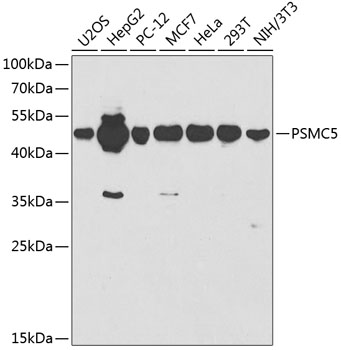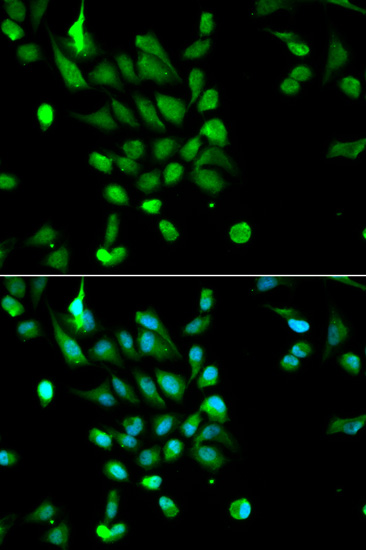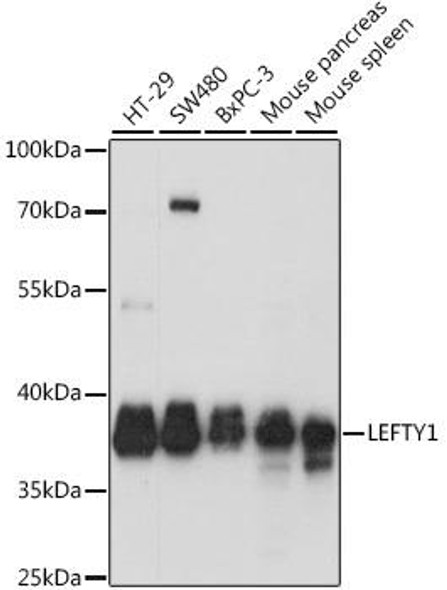Cell Biology Antibodies 6
Anti-PSMC5 Antibody (CAB1538)
- SKU:
- CAB1538
- Product Type:
- Antibody
- Reactivity:
- Human
- Reactivity:
- Mouse
- Reactivity:
- Rat
- Host Species:
- Rabbit
- Isotype:
- IgG
- Antibody Type:
- Polyclonal Antibody
- Research Area:
- Cell Biology
Description
| Antibody Name: | Anti-PSMC5 Antibody |
| Antibody SKU: | CAB1538 |
| Antibody Size: | 20uL, 50uL, 100uL |
| Application: | WB IF |
| Reactivity: | Human, Mouse, Rat |
| Host Species: | Rabbit |
| Immunogen: | Recombinant fusion protein containing a sequence corresponding to amino acids 127-406 of human PSMC5 (NP_002796.4). |
| Application: | WB IF |
| Recommended Dilution: | WB 1:500 - 1:2000 IF 1:50 - 1:200 |
| Reactivity: | Human, Mouse, Rat |
| Positive Samples: | U2OS, HepG2, PC-12, MCF7, HeLa, 293T, NIH/3T3 |
| Immunogen: | Recombinant fusion protein containing a sequence corresponding to amino acids 127-406 of human PSMC5 (NP_002796.4). |
| Purification Method: | Affinity purification |
| Storage Buffer: | Store at -20'C. Avoid freeze / thaw cycles. Buffer: PBS with 0.02% sodium azide, 50% glycerol, pH7.3. |
| Isotype: | IgG |
| Sequence: | LPNK VDPL VSLM MVEK VPDS TYEM IGGL DKQI KEIK EVIE LPVK HPEL FEAL GIAQ PKGV LLYG PPGT GKTL LARA VAHH TDCT FIRV SGSE LVQK FIGE GARM VREL FVMA REHA PSII FMDE IDSI GSSR LEGG SGGD SEVQ RTML ELLN QLDG FEAT KNIK VIMA TNRI DILD SALL RPGR IDRK IEFP PPNE EARL DILK IHSR KMNL TRGI NLRK IAEL MPGA SGAE VKGV CTEA GMYA LRER RVHV TQED FEMA VAKV MQKD SEKN MSIK KLWK |
| Gene ID: | 5705 |
| Uniprot: | P62195 |
| Cellular Location: | Cytoplasm, Nucleus |
| Calculated MW: | 44kDa/45kDa |
| Observed MW: | 46kDa |
| Synonyms: | PSMC5, S8, SUG-1, SUG1, TBP10, TRIP1, p45, p45/SUG, ATPase 5 |
| Background: | The 26S proteasome is a multicatalytic proteinase complex with a highly ordered structure composed of 2 complexes, a 20S core and a 19S regulator. The 20S core is composed of 4 rings of 28 non-identical subunits; 2 rings are composed of 7 alpha subunits and 2 rings are composed of 7 beta subunits. The 19S regulator is composed of a base, which contains 6 ATPase subunits and 2 non-ATPase subunits, and a lid, which contains up to 10 non-ATPase subunits. Proteasomes are distributed throughout eukaryotic cells at a high concentration and cleave peptides in an ATP/ubiquitin-dependent process in a non-lysosomal pathway. An essential function of a modified proteasome, the immunoproteasome, is the processing of class I MHC peptides. This gene encodes one of the ATPase subunits, a member of the triple-A family of ATPases which have a chaperone-like activity. In addition to participation in proteasome functions, this subunit may participate in transcriptional regulation since it has been shown to interact with the thyroid hormone receptor and retinoid X receptor-alpha. Two transcript variants encoding different isoforms have been found for this gene. |
| UniProt Protein Function: | RPT6: The 26S protease is involved in the ATP-dependent degradation of ubiquitinated proteins. The regulatory (or ATPase) complex confers ATP dependency and substrate specificity to the 26S complex. Belongs to the AAA ATPase family. |
| UniProt Protein Details: | Protein type:Nuclear receptor co-regulator; Proteasome complex; Ubiquitin conjugating system Chromosomal Location of Human Ortholog: 17q23.3 Cellular Component: nucleoplasm; proteasome complex; membrane; proteasome regulatory particle; cytoplasm; inclusion body; cytoplasmic vesicle; nucleus; cytosol Molecular Function:thyrotropin-releasing hormone receptor binding; protein binding; TATA-binding protein binding; ATPase activity; transcription cofactor activity; transcription factor binding; ATP binding Biological Process: positive regulation of ubiquitin-protein ligase activity during mitotic cell cycle; transcription from RNA polymerase II promoter; proteasomal ubiquitin-dependent protein catabolic process; negative regulation of ubiquitin-protein ligase activity during mitotic cell cycle; protein polyubiquitination; viral reproduction; apoptosis; positive regulation of transcription, DNA-dependent; antigen processing and presentation of exogenous peptide antigen via MHC class I, TAP-dependent; DNA damage response, signal transduction by p53 class mediator resulting in cell cycle arrest; regulation of apoptosis; antigen processing and presentation of peptide antigen via MHC class I; regulation of ubiquitin-protein ligase activity during mitotic cell cycle; anaphase-promoting complex-dependent proteasomal ubiquitin-dependent protein catabolic process; negative regulation of programmed cell death; antigen processing and presentation of exogenous peptide antigen via MHC class I; gene expression; mitotic cell cycle; regulation of amino acid metabolic process; negative regulation of transcription, DNA-dependent; G1/S transition of mitotic cell cycle; negative regulation of apoptosis |
| NCBI Summary: | The 26S proteasome is a multicatalytic proteinase complex with a highly ordered structure composed of 2 complexes, a 20S core and a 19S regulator. The 20S core is composed of 4 rings of 28 non-identical subunits; 2 rings are composed of 7 alpha subunits and 2 rings are composed of 7 beta subunits. The 19S regulator is composed of a base, which contains 6 ATPase subunits and 2 non-ATPase subunits, and a lid, which contains up to 10 non-ATPase subunits. Proteasomes are distributed throughout eukaryotic cells at a high concentration and cleave peptides in an ATP/ubiquitin-dependent process in a non-lysosomal pathway. An essential function of a modified proteasome, the immunoproteasome, is the processing of class I MHC peptides. This gene encodes one of the ATPase subunits, a member of the triple-A family of ATPases which have a chaperone-like activity. In addition to participation in proteasome functions, this subunit may participate in transcriptional regulation since it has been shown to interact with the thyroid hormone receptor and retinoid X receptor-alpha. Two transcript variants encoding different isoforms have been found for this gene. [provided by RefSeq, Nov 2010] |
| UniProt Code: | P62195 |
| NCBI GenInfo Identifier: | 49065819 |
| NCBI Gene ID: | 5705 |
| NCBI Accession: | P62195.1 |
| UniProt Secondary Accession: | P62195,O35051, O43208, P47210, P52915, P52916, A8K3Z3 A8K763, |
| UniProt Related Accession: | P62195 |
| Molecular Weight: | 406 |
| NCBI Full Name: | 26S protease regulatory subunit 8 |
| NCBI Synonym Full Names: | proteasome (prosome, macropain) 26S subunit, ATPase, 5 |
| NCBI Official Symbol: | PSMC5 |
| NCBI Official Synonym Symbols: | S8; p45; SUG1; SUG-1; TBP10; TRIP1; p45/SUG |
| NCBI Protein Information: | 26S protease regulatory subunit 8; MSUG1 protein; proteasome subunit p45; thyroid receptor interactor 1; Tat-binding protein homolog 10; proteasome 26S ATPase subunit 5; proteasome 26S subunit ATPase 5; 26S proteasome AAA-ATPase subunit RPT6; thyroid horm |
| UniProt Protein Name: | 26S protease regulatory subunit 8 |
| UniProt Synonym Protein Names: | 26S proteasome AAA-ATPase subunit RPT6; Proteasome 26S subunit ATPase 5; Proteasome subunit p45; Thyroid hormone receptor-interacting protein 1; TRIP1; p45/SUG |
| Protein Family: | 26S protease regulatory |
| UniProt Gene Name: | PSMC5 |
| UniProt Entry Name: | PRS8_HUMAN |








